I know, I know… late for the update on speedlights. I apologize a thousand times. Been unimaginably busy, and things have drifted. Bermuda workshop was so intense there was no time left for much other than sleeping (and a little dancing to reggae on the beach… but, I digress.) NOTE: This is part two of the Speedlight series: Part one is here.
This week we are going to look at using one speedlight with no modifications… no umbrellas or softboxes to modify the light, just the bare strobe. This can sometimes seem like pretty harsh light, but there ways to use the single light that can create a very modern, clean and sometimes become almost not noticeable.
We will take a look at a group of images that use only one strobe, in different ways. I want you to try some of these shots when you get a chance. I use a stand or a human boom (assistant) to position the light, and it is very important that it is positioned perfectly.
The line from the camera to the subject is called the axis. It is one third of the triangle caused by the placement of the light, the subject and the camera. The wider that triangle, the more shadow is caused from the light across the subject. Keeping the light on axis of the camera can create less angular shadows. Keeping it on axis of the subject can create less angular shadows as well, especially the nose and chin area. You will have to make the determination on how that works for you as you are shooting.
First up is Megan in Seattle. I had her sitting on a small table near the water in Pike Market. The sun was about an hour from sunset so it is kind of low on the horizon, but not a ‘setting sun’ by any means.
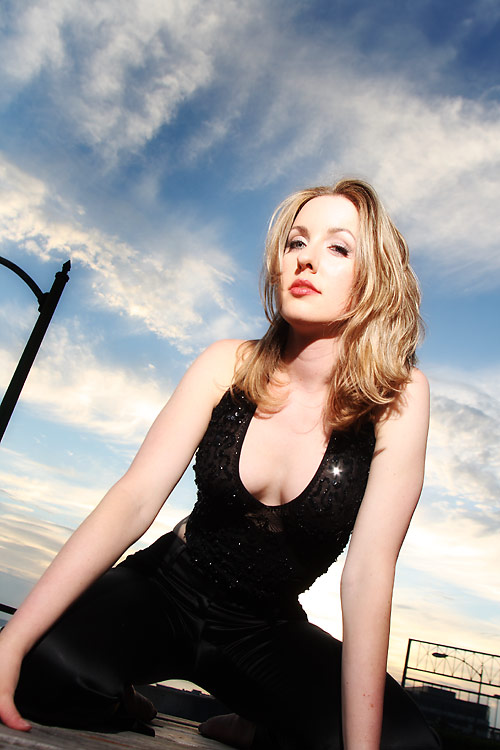
For this shot I used a speedlight in close and at lower power for faster recycle. It also creates a kind of spotlight look that I like a lot as the proximity of the flash and the subject are so close that the light doesn’t have the distance to ‘spread’ and cover more subject.
Notice the small shadow on her nose and the direction of the shadow under her chin. This is a direct affect of the position of the strobe. In this case, I was making sure the angle of the light and her face were as close to ‘axis’ as possible… even moving the light as she moved to maintain that angle. The strobe is slightly off to the camera right by a few inches and we still get that shadow. (It doesn’t bother me, and the ‘hot’ effect is exactly what I wanted… a dramatic hard light that adds a bit of drama.)
In this contact sheet you can see how keeping the light in context with the angle of her face mitigates the shadows that may be caused if the light remained stationary.
If the light had been stationary to any angle, the shadows would have grown and diminished as she moved her head. I kept the light right into her face from a very slight angle wherever she moved. This mitigated long nose shadows and chin shadows that could have been distracting.
Below are a couple of shots I recently did of Trikita in Bermuda. I wanted the red dress to stand out and her pose to be almost statuesque.
Using the natural light as ambient fill, I wanted the speedlight to seem like an un-natural light source… a shining beam of light that was totally at odds with the surroundings. The sun is high overhead, and slightly… very slightly behind Trikita to the camera left of her. You can see the sun causing a hot spot on her elbow on the left shot, on the right shot you can see how it is lighting up the old fort walls around her. The light is without shape at noon, simply falling straight down on the landscape.
Using a single speedlight, I went from the opposite side of the sun and kept the axis of the light straight into her face. This was an effort to keep the face and dress well lit and not cause any more shadows than necessary on her face, but allow the light to shape and augment the dress’ shape and design.
Keeping it to one added source I allowed the light to ‘fall off’ as it went down her dress. This light to dark gradation adds some interest to the image as well. It plays well off of the underexposed, rather flat, ambient light.
For this shot I underexposed the background 1.5stops. The ambient exposure was f16 at 1/125 so I moved the aperture to f-22 (1 stop darker than the metered light) and moved my shutter speed to 1/200 (2/3 less exposure from ambient – close enough for me to call it 1/2). Then I moved my flash into the range to give me f-22. In this case it was about 6 feet from her at 1/2 power, zoomed to 50mm. The shot setting of f-22 @ 1/200 resulted in good exposure for the flash lit area and a 1.5 underexposed ambient area.
The next image is one I like a lot. Briana on a deserted dirt road in Prescott. I loved the setting sun and the moon was an extra special catch.
I used the flash as an on-axis fill for this shot. You can catch the slight shadows from her legs going back from the camera. This cross shadow effect is kinda fun, and the light is doing a great job of showing her form and expression. With the sun as the only light source, I would have had shadows from her nose, chin, cheeks and even hair. I didn’t want any extraneous shadows on her, so I elected to fill in from camera axis to eliminate the shadows that were caused from the sun.
I used a 550EX at perfect balance to the setting sun. This allows the sun to be my right side light, and the strobe gives me the main. Briana is well lit without difficult shadows. The 550 is being held in my right hand and is as high as I could get it, and very slightly to camera right axis to give the light a tiny bit of ‘shape’.
Otero, the Bermuda model that can jump over the moon if asked, did this shot with me during the workshop. I wanted to do something with all the models so I had the two ladies stand in the surf and asked Otero to do one of his martial arts jumps for me. I had one of the workshop attendees hold the flash and I had Otero jump on ‘three’.
This shot uses the sun as the main light, and adds the strobe to open the shadows and add some pop to Otero… especially in the shadows as he crunches up.
Sun was f-16 at 1/125 at ISO 200, so I made the strobe equal that by putting it on 1/2 power and metering in the spot where f-16 would occur. That is the precise spot I wanted Otero to jump in. By making the strobe equal in power to the sun, I opened the shadows and ‘popped’ the colors of his clothes and skin. You will notice that the models and the ambient surroundings are also lit correctly. Using the flash at equal power does not mean that it will ‘overpower’ the sun.
My human-boom assistant was very careful to consistently aim the flash at Otero’s face, not watching me… but the talent. The two models were directed to the look of distraction and the light fell on them well because I turned their faces away from the harsh light of the day. Without turned heads, shadowed eyesockets and under nose would have killed the shot.
The wind was crazy on the mountains outside of Palm Springs when I made this shot of Briana. I wanted to include the windmills and the strange landscape. But I wanted Briana to dominate the shot. How better to do it than use a speedlight to light her from a different angle than the sun, and underexpose the sunlight a little as well, deadening the color.
The light was heavy overcast, so it was flat and uninteresting. I didn’t want the light I provided to be flat as well, so I decided on a sidelight look. Holding the light at about 30 degrees to camera left, I was able to create the look of light from a direction, instead of from above. the slightly zoomed nature of the light created that pool of light that I like and the exposure was created to be one stop over ambient. That means that the ambient exposure (f-8 at 1/125 was allowed to be one stop under exposed by shooting the flash at f-11 (at 1/125) at ISO 100. The flash exposure of f-11 renders the f-8 exposure as one stop underexposed. This makes Briana ‘pop’ from the background and really shows off the colors of her dress.
The light is a Canon 430 on a collapsed stand that I am holding like a boom on my left hip. I wanted the light to come down instead of across at her. The light is close and slightly out of camera range to camera left. It is set to 1/8 power for fast recycle and the overcast day made that plenty of light. The strobe is zoomed to 50mm for a slightly narrow throw.
Notice how the angle of the strobe doesn’t show harsh shadows on Briana’s face. I was carefully watching the angles of her face and following it with the strobe on the stand on my hip. Takes a little doing, but it can certainly be done.
Our last shot is Megan, a friend of mine who is also a photographer and a doctor.
I wanted the feeling of light coming both ways on her as it pertains to the kind of doctoring she does. The sun was very low and it came through the dead plants with such warmth that I wanted to keep that look to the image as well. The light is a single 430EZ on a stand to camera right, slightly above Megan’s head and slightly tilted down. Zoom is all the way wide to give maximum coverage. I metered the ambient and set the strobe to match it. In other words, the strobe is giving the same light towards Megan as the exposure would be from the sun on her back.
Notice again how having Megan’s face turned ‘toward’ the light gave less shadows on the face and added to the overall feeling of softer light.
I will add a few more to this post as the week progresses, so check back again.
Thanks for visiting Lighting Essentials, a place for photographers.

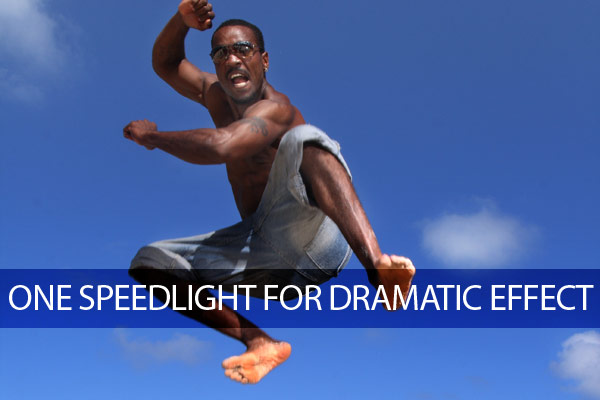
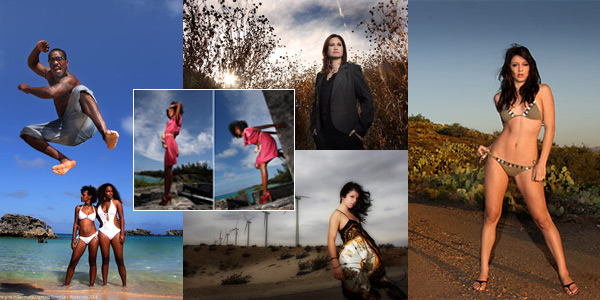
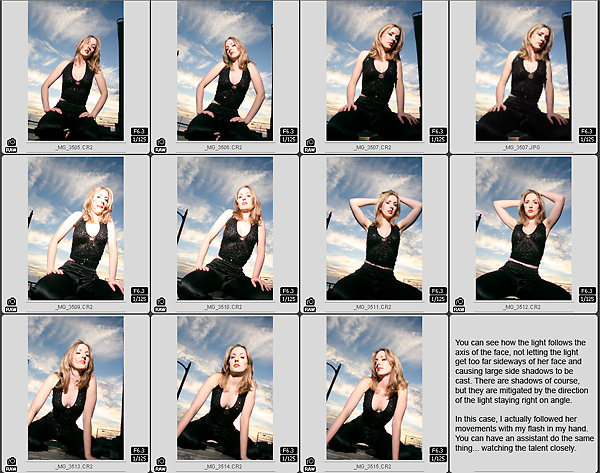
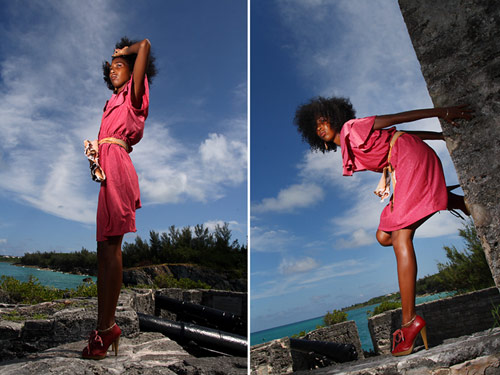
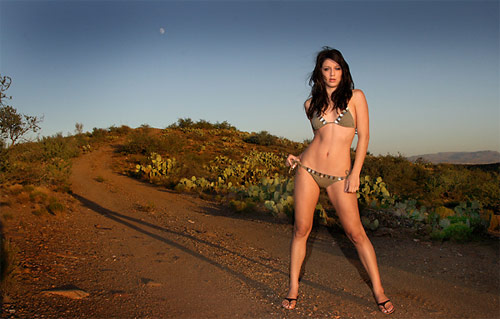
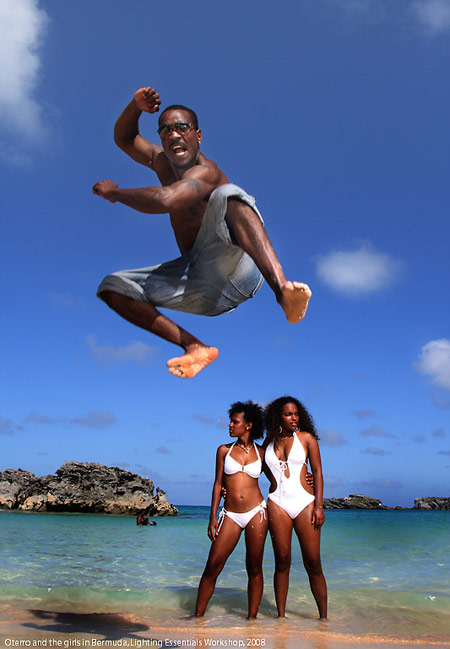
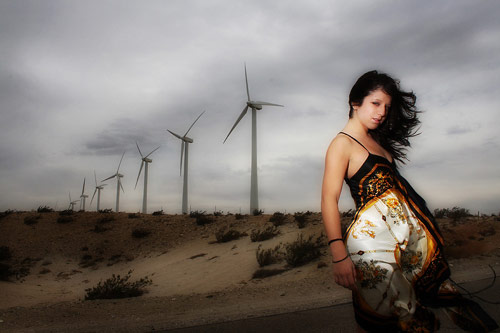
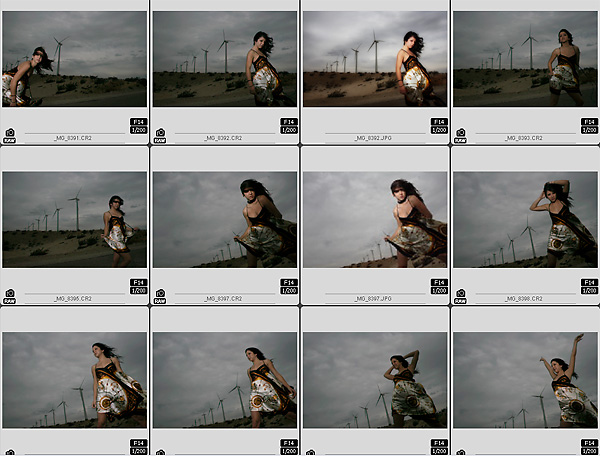





as usual,, thank you for the excelant tutorials!
Hi,
Excellent explanations – you make it all sound very simple.
I really love these pictures – particularly the Doctor and the jumping model. The Doctor shot has a painterly look to it – very well done!
I’m not too keen on the first one – the model sitting on the table. The light really does look too harsh to me and not that flattering. Of course – just personal taste.
I have also started using single naked strobe off camera light at my weddings around sunset to really give a spicy look to the skies while keeping the subjects in the light. Makes a world of difference.
Thanks for sharing all this with the community!
Excelent explanation. I am waiting the second part. Congratulations.
Thanks for make my fotographer life easy.
I have a few beach shoots coming up and found this article very useful for lighting conditions in very strong backlit sun. Like the equalisation of lighting with strobe…very useful Thanks